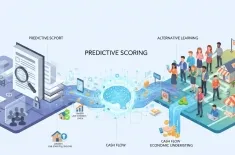Explore how Generative AI & LLMs revolutionize financial planning with hyper-personalized advice, advanced scenario modeling
The financial services landscape is undergoing a radical transformation, driven by the emergence of Generative AI finance. This technology is moving beyond simple automation to fundamentally alter the core process of financial planning, turning static, generalized advice into dynamic, highly personalized advice for every client. The deployment of advanced models—chiefly Large Language Models (LLMs)—is ushering in an era of hyper-efficiency, sophisticated risk simulation, and unparalleled customization in wealth management.
The Engine of Change: How LLMs Power Personalized Financial Advice
At the heart of this revolution are LLM financial planners. These Large Language Models, which are a subset of Generative AI, are not merely sophisticated chatbots; they are advanced analytical engines capable of synthesizing colossal amounts of structured and unstructured data to provide complex, human-like reasoning.
Synthesizing Complex Financial Data
The traditional financial planning process is limited by a human advisor's capacity to ingest, analyze, and cross-reference information. Generative AI shatters this limitation.
Ingesting Unstructured Data:
Generative AI models can process and understand data that has historically been inaccessible to automated tools. This includes:
- Regulatory Filings: Interpreting the nuances of new tax laws, SEC rules, and market regulations in real-time.
- Market News & Sentiment: Analyzing thousands of news articles, earnings call transcripts, and social media sentiment to gauge market perception and geopolitical risk.
- Client Documents: Reading, summarizing, and extracting key details from wills, trusts, insurance policies, and employment contracts.
Structuring and Synthesizing:
Using sophisticated techniques like Natural Language Processing (NLP) and Retrieval-Augmented Generation (RAG), the LLMs don't just read the data; they connect the dots. RAG, for instance, allows the AI to reference a constantly updated, proprietary database of financial knowledge before generating a response. This ensures the advice is both contextually relevant (from the client's file) and factually accurate (from the verified knowledge base).
Generating Dynamic, Context-Aware Content:
Once the data is synthesized, the AI generates a coherent, grammatically flawless narrative—a truly personalized financial plan. This output moves far beyond templated paragraphs to deliver advice that sounds as if it were written by a top-tier human advisor, explaining complex concepts in simple, client-friendly language. This capability for personalized advice ensures clients are not just told what to do, but why they should do it, significantly boosting financial literacy and engagement.
Advancing Planning: Scenario Modeling and Risk Simulation
One of Generative AI's most impactful applications is its ability to perform high-fidelity financial modeling, which dramatically improves strategic planning and risk assessment.
Scenario Modeling for Life's "What Ifs"
Scenario modeling is a core component of future-proof financial planning. Historically, advisors could only run a few static scenarios due to time constraints (e.g., "What if you retire at 65 with a 4% withdrawal rate?"). Generative AI transforms this into an iterative, dynamic, and exhaustive process.
The AI can instantaneously generate and evaluate hundreds of interconnected scenarios based on the client's unique profile, allowing the client and advisor to explore:
- Career Changes: Modeling the impact of a five-year sabbatical, a mid-career pivot into a lower-paying but more fulfilling role, or an early retirement at age 60.
- Major Purchases: Generating a detailed cash flow analysis for buying a new home in a specific city, including projected property tax increases, insurance costs, and the optimal down payment amount.
- Estate Planning Complexity: Modeling the tax and liquidity impact of various wealth transfer strategies under different future tax regimes.
High-Fidelity Risk Simulation
For risk simulation, Generative AI goes beyond simple portfolio volatility analysis. It uses Generative Adversarial Networks (GANs) and other models to create millions of synthetic market scenarios that mimic real-world market movements with a level of complexity and interaction that traditional Monte Carlo simulations cannot match.
This capability allows the system to:
- Stress Test Portfolios: Simulate 'Black Swan' events that have never occurred historically (e.g., a simultaneous crash in US equities and a spike in bond rates), showing the client exactly how their portfolio would perform under extreme duress.
- Optimize Asset Allocation: Recommend adjustments to a portfolio—not just based on historical returns—but on the AI’s generative understanding of future risk correlations across global markets.
- Customize Risk Tolerance: Dynamically adjust a client’s risk profile by observing their behavioral response to hypothetical losses presented by the AI, leading to a more accurate and emotionally robust financial plan.
Transforming Wealth Management
Generative AI is fundamentally re-tooling wealth management by enhancing both the client experience and advisor productivity.
Augmenting the Human Financial Advisor
Rather than replacing human advisors, Generative AI acts as an incredibly powerful copilot.
- Research & Preparation: An LLM can instantly summarize hundreds of pages of quarterly market reports, distill a client's 10-year financial history into three key insights, and draft a personalized advice email for an upcoming review meeting, highlighting the one or two most critical discussion points. This frees up the human advisor to focus on empathy, behavioral coaching, and complex negotiations.
- Compliance & Documentation: The AI can draft compliance documents, ensure all regulatory disclosures are included, and even monitor the advisor's client communications in real-time to mitigate legal and regulatory risk. This is a crucial application of Generative AI finance in a highly regulated industry.
Enhancing Client Experience and Engagement
For the client, the experience is transformed:
- 24/7 Virtual Assistant: Clients can interact with an AI-powered conversational interface, asking complex questions about their retirement projection or tax implications. The LLM financial planners retrieve the necessary data, run the calculation, and generate a clear, concise answer, often supplemented by a dynamically generated graph or chart.
- Adaptive Planning: The financial plan is no longer a document filed away once a year. It is a living, dynamic entity. As soon as a client's spending changes, an LLM financial planner detects the anomaly, models its impact on the long-term goal, and proactively generates a suggestion for adjustment.
The Future: Ethical Considerations and Governance
While the benefits of Generative AI finance are immense, the technology is not without its challenges. Accuracy, compliance, and ethical governance are paramount, especially when dealing with sensitive client data.
Hallucinations and Accuracy
LLMs can sometimes "hallucinate"—generate false or misleading information. In financial planning, an AI hallucination could lead to catastrophic investment advice. Consequently, the most robust systems utilize the RAG framework to ground the LLM's output in verifiable, fact-checked, domain-specific data. Furthermore, a "human-in-the-loop" oversight is essential, where the human advisor always curates and validates the final personalized advice before it is presented to the client.
Data Privacy and Compliance
The use of Generative AI in wealth management requires rigorous adherence to data privacy regulations. Financial institutions must ensure that sensitive client data used for training models or running risk simulation remains secure and fully compliant with global data protection laws (like GDPR or CCPA). The industry is increasingly adopting internal, domain-specific LLMs run on private servers to maintain a high degree of security and control.
In conclusion, Generative AI marks the next inflection point for the financial industry. By leveraging the power of advanced language models to synthesize complex data, run precise scenario modeling, and deliver truly personalized advice, it is transforming the role of the advisor from a data processor into a strategic, relational partner, ultimately leading to better, more adaptive, and more accessible financial planning for everyone.





























